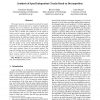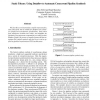ASYNC
2004
IEEE
14 years 6 months ago
2004
IEEE
This paper presents a decomposition method for speedindependent circuit design that is capable of significantly reducing the cost of synthesis. In particular, this method synthesi...
ASYNC
2004
IEEE
14 years 6 months ago
2004
IEEE
We describe a new intermediate compiler representation, static token form, that is suitable for dataflow-style synthesis of high-level asynchronous specifications. Static token fo...
ASYNC
2004
IEEE
14 years 6 months ago
2004
IEEE
We analyze an Alpha 21264-like Globally
ASYNC
2004
IEEE
14 years 6 months ago
2004
IEEE
One of the main reasons for using asynchronous design is that it offers the opportunity to exploit the datadependent latency of many operations in order to achieve low-power, high...
ASYNC
2004
IEEE
14 years 6 months ago
2004
IEEE
We present some novel hardware implementations of a stack. All designs are clockless, fast, and energy efficient, while occupying modest area. We implemented a 42-place stack chip...
ASYNC
2004
IEEE
14 years 6 months ago
2004
IEEE
Register files of microprocessors have often been cited as performance bottlenecks and significant consumers of energy. The robust and modular nature of quasi-delay insensitive (Q...
ASYNC
2004
IEEE
14 years 6 months ago
2004
IEEE
I use asynchronous FIFO stages that are connected in rings to generate and deliver highly precise timing signals. I introduce a Micropipeline FIFO control stage that oscillates at...
ASYNC
2004
IEEE
14 years 6 months ago
2004
IEEE
De-synchronization appears as a new paradigm to automate the design of asynchronous circuits from synchronous netlists. This paper studies different protocols for de-synchronizatio...
ASYNC
2004
IEEE
14 years 6 months ago
2004
IEEE
As integrated circuit technologies get smaller, circuit and architectural trends make transmitting data across long on-chip wires increasingly important yet increasingly expensive...




